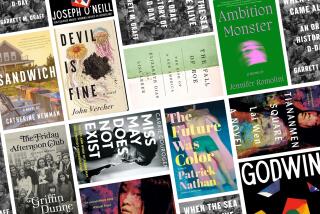On the Media: Publisher Sara Miller McCune has serious goals for journalism
Reporting From Santa Barbara — — Revenue plummets right along with dreary circulation. Time slashes its staff. Newsweek hovers near extinction. Survival and stable footing seem assured only for the frothiest and most specialized magazines.
Yet one woman looks into this bleak media sea and sees an opportunity, if not to make money, to fill a void with serious, solutions-oriented journalism.
The result is Miller-McCune, a bimonthly journal that focuses on social issues and public policy with the same passion that supermarket glossies lavish on “Biggest Loser” photo spreads and Heidi Montag’s latest turn under the plastic surgeon’s knife.
Though virtually unknown to the general public, the 100,000-circulation magazine and a companion website (www.miller-mccune.com) have gained a toehold with academics, government officials and journalists.
Sara Miller McCune of Santa Barbara created the magazine two years ago to bring a wider public to the sort of social science research that her academic and journal publishing company, Sage Publications, has nurtured for 45 years.
Miller-McCune, the magazine, comes across as that bright and earnest new student, full of promise but still striving to get closer to the head of the class. Its greatest gift is a founder and president who is that rare creature — willing to pay for quality reporting and writing without demanding editorial control.
Charles Peters, the acclaimed founder and former editor of the Washington Monthly, said Miller-McCune landed on his desk one day about a year ago. “I like it,” Peters said. “It has an independent, original cast of mind.”
Miller McCune and her late husband, George, had talked for many years about trying to expand the impact of the research they helped spread via the more than 560 academic journals — including “Autism,” “International Sociology” and “Youth Justice” — that they published.
In 2007, the publishing magnate committed roughly $2.2 million a year for five years to launch the magazine, a commitment she intends to extend. That’s been enough to print six editions a year and launch the website, which is updated more frequently.
“It’s all very well and good to be publishing the academic literature,” Miller McCune, 69, said this week at her home in the hills here, “but if it isn’t penetrating into the minds of policymakers, the corporate leaders, the people who count … then you are not doing the whole job.”
The newly created Miller-McCune Center for Research, Media and Public Policy chose John Mecklin, previously editor of highly regarded High Country News, as its first editor in chief.
Under the slogan “Smart Journalism, Real Solutions,” Miller-McCune tries to set itself apart by teaming thoughtful social science research with policy prescriptions.
The May/June cover story, “Make Birth Control, Not War,” described the biological underpinnings of conflict — how wars tend to crop up as the population of young men increases. The journalist and evolutionary biologist who wrote the piece, Thomas Hayden and Malcolm Potts, advocated improved birth control and greater power for women over their own reproduction.
Miller-McCune stakes out provocative ground. One piece looked at safe-injection drug sites in Vancouver. It suggested addicts could find better outcomes with government cooperation, not crackdowns. As a subhead declared, “Let Junkies be Junkies.” Another story, “Innocent Until Reported Guilty,” argued that poor journalism has contributed to wrongful criminal convictions.
One of the most acclaimed of the magazine’s long think pieces, “Environment Becomes Heredity,” by science writer Valerie Brown, described how chemical exposure could be linked to multi-generational health problems. Improvements in nutrition and lifestyle could ward off some of the serious diseases handed down through generations, Brown wrote. The piece won an award from the Society of Environmental Journalists.
Miller-McCune could stand to expand its appeal beyond its wonky base. It’s currently mailed free of charge to most readers — the subscriptions divided somewhat equally between academics, business people and government policymakers.
To expand that base and add to its relative handful of paid subscriptions, the magazine will need to venture further from its roots and tell compelling stories using everyday characters from outside academia.
Some pieces, like last summer’s examination of the effect of racism on the health of African Americans, dwell more on researchers and research than on their human study subjects. One writer, who contributes regularly to the magazine, said that already he has seen some improvements from the “leaden” prose of the first few editions.
The magazine would seem to stand a fair chance of getting better, in large part because it rejects the 21st century nostrum that anyone and everyone can be a good writer. Miller-McCune pays a reasonable wage, often $5,000 or more for major take-outs, to attract journalists with substantial experience.
“We truly believe you get what you pay for in journalism,” said the soft-spoken Miller McCune, on a cane after suffering a leg injury.
The publisher has made a career of pulling off the improbable. She helped launch her first journal at barely 24 and, with her husband, built an international company that works relentlessly to expand its reach. She has shunted off repeated buyout offers for Sage, which has become one of the biggest academic journal publishers in the world. The company employs 1,000 people and by one account brought in $200 million in revenue in 2007.
In her philanthropic work, Miller McCune has funded such causes as development projects in India, restoration of the Granada Theatre in Santa Barbara, and the opening of the Sage Center for the Study of the Mind at UCSB, the latter at the cost of $3.5 million.
She knows some are skeptical about the viability of a serious magazine, launched in the midst of a recession. But she doesn’t mind. “I’ve always had a certain confidence,” she said, “that things will work out.”
Twitter: latimesrainey



